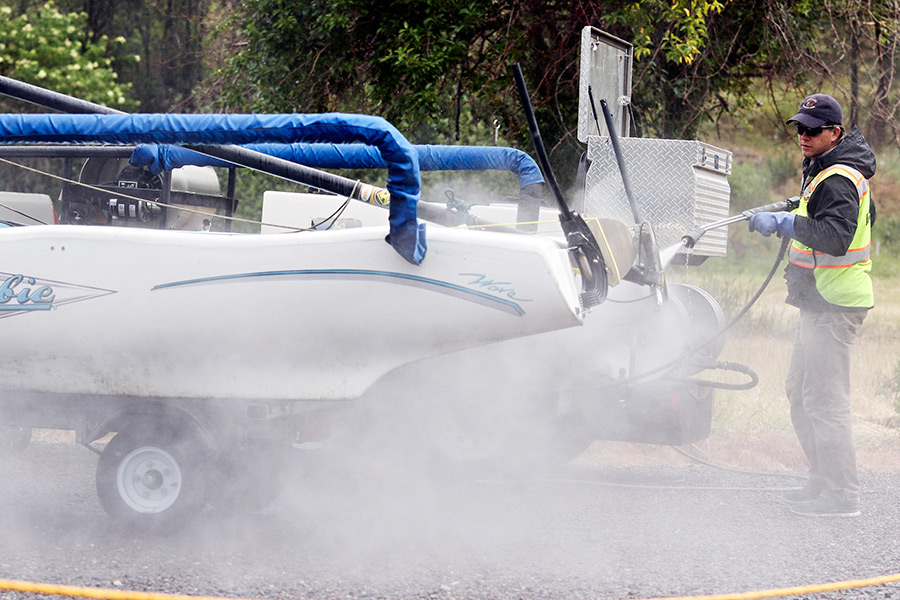Watercraft Inspections Resume in Northwest Montana
In an effort to prevent the spread of aquatic invasive species, boaters entering the Flathead Basin are required to undergo inspections prior to launching
By Tristan Scott
With the arrival of warmer weather, the return of snowbird boat traffic and the start of a popular fishing derby on Flathead Lake, early-season watercraft inspections have opened at strategic locations in western Montana, including in Ravalli and Kalispell, with additional facilities coming online across the state.
All watercraft coming to Montana must be inspected for aquatic invasive species at a Montana watercraft inspection station prior to launch.
The increased visibility of inspection stations is becoming a familiar indicator of spring in Montana following the November 2016 discovery of destructive mussel larvae, or “veligers,” in Tiber and Canyon Ferry reservoirs east of the Continental Divide, marking the first time the invasive species have been detected in state waters and pulling a dire scenario into grim focus.
So far, the traces of contamination are restricted to the Missouri River Basin, but the likelihood of mussels hitchhiking on the hulls of boats or in bilge water or hidden away in irrigation equipment has prompted state and tribal agencies to launch a multi-pronged plan that includes bolstering perimeter defense to intercept mussel-fouled boats.
The stations that opened in early March include those near Dillon, Anaconda and Ravalli. Montana Fish, Wildlife and Parks (FWP) works closely with partners for station operation and contracts with the Confederated Salish and Kootenai Tribes (CSKT) for operation of the Ravalli station south of Polson. Inspections are also available at the FWP Region 1 office in Kalispell.
This year, watercraft restrictions at Tiber Reservoir are being evaluated for removal following no further detections of invasive mussels. FWP recently began the delisting process for Tiber as a mussel-positive waterbody and is accepting public comment through March.
Still, state and tribal officials haven’t let their guard down as they remain vigilant for mussel-fouled boats entering the state, as well as for boats crossing the Continental Divide from water bodies in eastern Montana.
During 2021, crews conducted 123,000 inspections and intercepted 61 mussel-fouled boats intercepted, which was a record number for the state. FWP warden staff, who provided support at inspection stations to prevent drive-bys, issued 137 citations and 182 written warnings. By comparison, a total of 35 mussel-fouled vessels were intercepted in 2020, according to FWP officials.
“Watercraft inspection stations are Montana’s first line of defense to prevent the movement of aquatic invasive species (AIS) which can have devastating impacts on Montana waterways,” according to an FWP press release announcing the opening of check stations this spring.
According to the release, boat owners should ensure their watercraft, trailers and gear are “clean, drained and dry” before transporting and should be aware of Montana’s inspection rules:
- All watercraft coming into Montana from out of state must be inspected prior to launching.
- All watercraft traveling west across the Continental Divide into the Columbia River Basin must be inspected prior to launching.
- Anyone transporting watercraft must stop at all open watercraft inspection stations they encounter.
- And all boaters are reminded to always clean drain and dry their boats and gear to help prevent the spread of AIS.
For now, local motorized and non-motorized boaters should visit the FWP Region 1 office at 490 North Meridian near the Flathead County Fairgrounds for an inspection, with hours extending from 8 a.m. to 5 p.m. Monday through Friday. The inspection station will increase its operational hours in April to include weekends and holidays. Additional inspection stations have also started opening across the state, including a station in Ravalli that the CSKT opened on March 12.
In Northwest Montana, the Spring Mack Days fishing derby began March 17, and all boats participating in the event must be inspected before launching at any site on Flathead Lake. Although the purpose of the fishing derby is to encourage the over-harvesting of invasive lake trout in Flathead Lake by offering cash incentives, it also increases early-season boating pressure on the largest freshwater lake west of the Mississippi, as well as the chances for a mussel-fouled boat to slip through unchecked.
Nonresidents boaters launching watercraft in Montana must purchase a Vessel AIS Prevention Pass, which costs $30 and applies to all motorized watercraft that is registered in another state or country. The fee for nonmotorized watercraft is $10 and applies to all non-motorized watercraft that nonresidents bring into Montana. Nonresidents can purchase the Vessel AIS Prevention Pass online at fwp.mt.gov or at any FWP office. Proof of purchase is an electronic or paper receipt. Nonresidents passing through Montana and not launching a watercraft are not required to purchase the pass.
AIS are introduced accidentally or intentionally outside of their native range. AIS populations, such as zebra or quagga mussels, can reproduce quickly and spread rapidly because there are no natural predators or competitors to keep them in check. AIS can displace native species, clog waterways, impact irrigation and power systems, degrade ecosystems, threaten recreational fishing opportunities, and can cause wildlife and public health problems.
For a map of the Flathead Basin, visit http://cleandraindry.mt.gov/Watercraft-Inspections.
For more information on Montana’s campaign to prevent aquatic invasive species, visit http://cleandraindry.mt.gov.